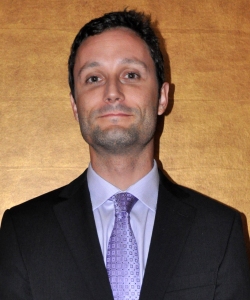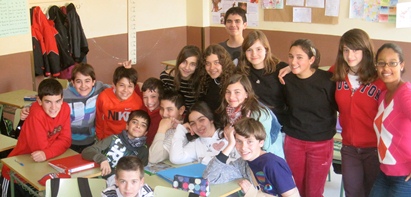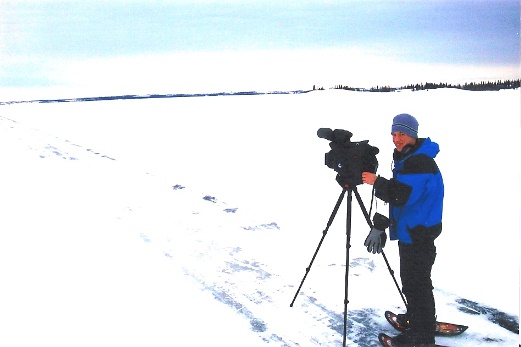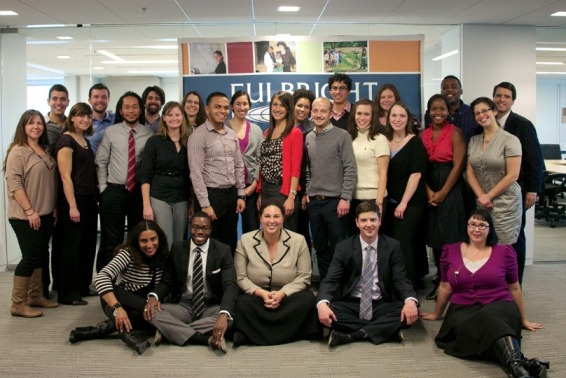
On Tuesday, December 11, 21 newly-selected 2013 Fulbright U.S. Student Program Alumni Ambassadors met in Washington, DC to receive training on how to promote and recruit for the Fulbright U.S. Student Program. Staff members from the U.S. Department of State’s Bureau of Educational and Cultural Affairs (ECA) and the Institute of International Education (IIE), along with previous Fulbright Alumni Ambassadors, shared tips on giving an effective presentation and emphasized the unique, important role that Fulbright Alumni Ambassadors play in inspiring diverse students, Fulbright Program Advisers, college administrators – and anyone interested in the program – to learn more about it and the power of educational and cultural exchange.
The Fulbright U.S. Student Alumni Ambassador Program was established in 2008 to identify, train and engage a select group of approximately 15-25 Fulbright U.S. Student Program alumni to serve as representatives, recruiters and spokespersons for the Fulbright Program. They are selected annually through recommendations from Fulbright Commissions, U.S. Embassy staff, area managers, the Fulbright Student Program Outreach Division and approved by the Fulbright Program’s sponsor, ECA. Fulbright Alumni Ambassadors come from an array of different ethnic and socio-economic backgrounds, states, fields of study, institutions and have participated in the Fulbright U.S. Student Program in all world areas.
Fulbright Alumni Ambassadors represent the program’s rich diversity and play a key role in increasing knowledge about Fulbright opportunities. They provide testimonials about their Fulbright experiences at conferences and campus presentations, and offer application tips in written articles, video and podcast interviews, webinars and at special events throughout the United States. The Fulbright U.S. Student Program relies on the Fulbright Alumni Ambassadors to share with potential applicants what the Fulbright experience is really like and how to successfully address the challenges of living abroad while meeting the Fulbright Program’s ultimate goal – to increase mutual understanding between the people of the United States and the people of other countries.
Here’s a preview of the 2013 Fulbright Alumni Ambassadors:
Stephanie Aigner
Current City: Jersey City, New Jersey
Undergraduate Institution: Seton Hall University
Fulbright ETA – Greece, 2010-2011
Marvin Alfaro
Current City: New York, New York
Undergraduate Institution: University of Miami
Fulbright CSIRO Postgraduate Scholarship – Australia, 2011-2012
April Conway
Current City: Athens, Georgia
Undergraduate Institution: University of Georgia
Fulbright U.S. Student in Ecology – Sierra Leone, 2010-2011
Emma Din
Current City: Washington, DC
Undergraduate Institution: University of North Carolina, Chapel Hill
Fulbright ETA – Colombia, 2011-2012
Justin Dunnavant
Current City: Gainesville, Florida
Undergraduate Institution: Howard University
Fulbright U.S. Student in Archeology – Jamaica, 2009-2010
Jared Finkelstein
Current City: Lubbock, Texas
Undergraduate Institution: Farmingdale State College
Fulbright U.S. Student in Construction Management Engineering Technology – Italy, 2010-2011
Esther Francis
Current City: Independence, Missouri
Undergraduate Institution: Park University
Fulbright U.S. Student in Business – Mexico, 2011-2012
Cristina Gauthier
Current City: San Juan, Puerto Rico
Undergraduate Institution: Polytechnic University of Puerto Rico
Fulbright U.S. Student in Environmental Studies – Brazil, 2010-2011
Nancy Guevara
Current City: Urbana, Illinois
Undergraduate Institution: University of Texas at Austin
Fulbright U.S. Student in Design – Mexico, 2011-2012
Zigfried Hampel-Arias
Current City: Madison, Wisconsin
Undergraduate Institution: Rice University
Fulbright U.S. Student in Physics – Argentina, 2009-2010
Kaitlen Howell
Current City: Nashville, Tennessee
Undergraduate Institution: Middle Tennessee State University
Fulbright U.S. Student in Medical Science – Germany, 2010-2011
Heather Michelle Hunt
Current City: Dallas, Texas
Undergraduate Institution: Southern Methodist University
Fulbright U.S. Student in Arabic Language and Literature – Egypt, 2011-2012
Sarah Lima
Current City: Cincinnati, Ohio
Undergraduate Institution: At-Large
Fulbright U.S. Student in Archeology – Albania, 2011-2012
Todd McKay
Current City: Salt Lake City, Utah
Undergraduate Institution: University of Utah
Fulbright ETA – Bangladesh, 2011-2012
Shadea Mitchell
Current City: Bloomington, Indiana
Undergraduate Institution: University of Louisville
Fulbright ETA – Jordan, 2010-2011
Deeneaus Polk
Current City: Pascagoula, Mississippi
Undergraduate Institution: University of Mississippi
Fulbright ETA – Germany, 2011-2012
Rachel Reetzke
Current City: Austin, Texas
Undergraduate Institution: Western Kentucky University
Fulbright U.S. Student in Public Health – China, 2011-2012
Jonathan Remple
Current City: San Francisco, California
Undergraduate Institution: Boston University
Fulbright ETA – Rwanda, 2010-2011
Marisa A. Rinkus
Current City: Lansing, Michigan
Undergraduate Institution: Purdue University
Fulbright U.S. Student in Environmental Studies – Brazil, 2010-2011
Munir Sayegh
Current City: Indianapolis, Indiana
Undergraduate Institution: St. Ambrose University
Fulbright U.S. Student in Design – Egypt, 2011-2012
Heather Yocum
Current City: Longmont, Colorado
Undergraduate Institution: University of Denver
Fulbright U.S. Student in Anthropology – Malawi, 2011-2012
Photo: (Back row, left to right) Antonio Tahhan (2012), Jonathan Remple, Munir Sayegh, Marisa Rinkus, Nancy Guevara, Cristina Gauthier, Zigfried Hampel-Arias, April Conway, Deeneaus Polk, Tony Claudino (IIE); (second row, left to right) Esther Francis, Sarah Lima, Justin Dunnavant, Heather Yocum, Marvin Alfaro, Rachel Reetzke, Todd McKay, Stephanie Aigner, Kaitlen Howell, Emma Din, Shadea Mitchell; (front row, left to right) Schuyler Allen (IIE), Lee Rivers (IIE), BJ McDuffie (ECA), Jamie Lawrence (ECA), Meg Neff (ECA; (not pictured), Mary Kirk (ECA), David Levin (ECA), Betsy Glans (IIE) and Walter Jackson (IIE)
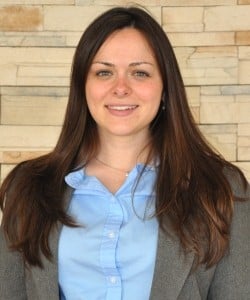 Megan Banick’s Fulbright Public Policy Fellowship placement is in the Guatemalan Ministry of Education as an Educational Researcher consulting on various education topics such as intercultural-bilingual education quality, civic education through student government, and international standardized testing. She is also leading a project for the Ministry on academic disinterest and cultural perceptions in Guatemala. Previously interning at a local NGO, she supported an agriculture and microbusiness training program in the same rural area where her current work will take place. Further, as an observer of a local mayoral candidate’s campaign, she gained a stronger understanding of the complex challenges facing democracy and public participation in rural, indigenous areas.
Megan Banick’s Fulbright Public Policy Fellowship placement is in the Guatemalan Ministry of Education as an Educational Researcher consulting on various education topics such as intercultural-bilingual education quality, civic education through student government, and international standardized testing. She is also leading a project for the Ministry on academic disinterest and cultural perceptions in Guatemala. Previously interning at a local NGO, she supported an agriculture and microbusiness training program in the same rural area where her current work will take place. Further, as an observer of a local mayoral candidate’s campaign, she gained a stronger understanding of the complex challenges facing democracy and public participation in rural, indigenous areas.

